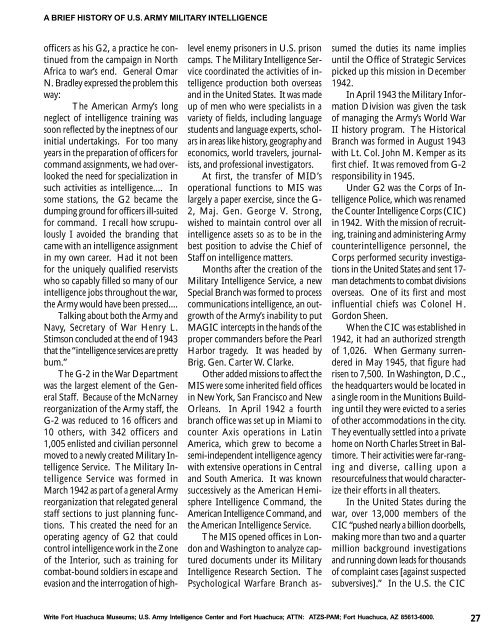Brief History of Army MI - Fort Huachuca - U.S. Army
Brief History of Army MI - Fort Huachuca - U.S. Army
Brief History of Army MI - Fort Huachuca - U.S. Army
Create successful ePaper yourself
Turn your PDF publications into a flip-book with our unique Google optimized e-Paper software.
A BRIEF HISTORY OF U.S. ARMY <strong>MI</strong>LITARY INTELLIGENCE<strong>of</strong>ficers as his G2, a practice he continuedfrom the campaign in NorthAfrica to war’s end. General OmarN. Bradley expressed the problem thisway:The American <strong>Army</strong>’s longneglect <strong>of</strong> intelligence training wassoon reflected by the ineptness <strong>of</strong> ourinitial undertakings. For too manyyears in the preparation <strong>of</strong> <strong>of</strong>ficers forcommand assignments, we had overlookedthe need for specialization insuch activities as intelligence.... Insome stations, the G2 became thedumping ground for <strong>of</strong>ficers ill-suitedfor command. I recall how scrupulouslyI avoided the branding thatcame with an intelligence assignmentin my own career. Had it not beenfor the uniquely qualified reservistswho so capably filled so many <strong>of</strong> ourintelligence jobs throughout the war,the <strong>Army</strong> would have been pressed....Talking about both the <strong>Army</strong> andNavy, Secretary <strong>of</strong> War Henry L.Stimson concluded at the end <strong>of</strong> 1943that the “intelligence services are prettybum.”The G-2 in the War Departmentwas the largest element <strong>of</strong> the GeneralStaff. Because <strong>of</strong> the McNarneyreorganization <strong>of</strong> the <strong>Army</strong> staff, theG-2 was reduced to 16 <strong>of</strong>ficers and10 others, with 342 <strong>of</strong>ficers and1,005 enlisted and civilian personnelmoved to a newly created Military IntelligenceService. The Military IntelligenceService was formed inMarch 1942 as part <strong>of</strong> a general <strong>Army</strong>reorganization that relegated generalstaff sections to just planning functions.This created the need for anoperating agency <strong>of</strong> G2 that couldcontrol intelligence work in the Zone<strong>of</strong> the Interior, such as training forcombat-bound soldiers in escape andevasion and the interrogation <strong>of</strong> highlevelenemy prisoners in U.S. prisoncamps. The Military Intelligence Servicecoordinated the activities <strong>of</strong> intelligenceproduction both overseasand in the United States. It was madeup <strong>of</strong> men who were specialists in avariety <strong>of</strong> fields, including languagestudents and language experts, scholarsin areas like history, geography andeconomics, world travelers, journalists,and pr<strong>of</strong>essional investigators.At first, the transfer <strong>of</strong> <strong>MI</strong>D’soperational functions to <strong>MI</strong>S waslargely a paper exercise, since the G-2, Maj. Gen. George V. Strong,wished to maintain control over allintelligence assets so as to be in thebest position to advise the Chief <strong>of</strong>Staff on intelligence matters.Months after the creation <strong>of</strong> theMilitary Intelligence Service, a newSpecial Branch was formed to processcommunications intelligence, an outgrowth<strong>of</strong> the <strong>Army</strong>’s inability to putMAGIC intercepts in the hands <strong>of</strong> theproper commanders before the PearlHarbor tragedy. It was headed byBrig. Gen. Carter W. Clarke.Other added missions to affect the<strong>MI</strong>S were some inherited field <strong>of</strong>ficesin New York, San Francisco and NewOrleans. In April 1942 a fourthbranch <strong>of</strong>fice was set up in Miami tocounter Axis operations in LatinAmerica, which grew to become asemi-independent intelligence agencywith extensive operations in Centraland South America. It was knownsuccessively as the American HemisphereIntelligence Command, theAmerican Intelligence Command, andthe American Intelligence Service.The <strong>MI</strong>S opened <strong>of</strong>fices in Londonand Washington to analyze captureddocuments under its MilitaryIntelligence Research Section. ThePsychological Warfare Branch assumedthe duties its name impliesuntil the Office <strong>of</strong> Strategic Servicespicked up this mission in December1942.In April 1943 the Military InformationDivision was given the task<strong>of</strong> managing the <strong>Army</strong>’s World WarII history program. The HistoricalBranch was formed in August 1943with Lt. Col. John M. Kemper as itsfirst chief. It was removed from G-2responsibility in 1945.Under G2 was the Corps <strong>of</strong> IntelligencePolice, which was renamedthe Counter Intelligence Corps (CIC)in 1942. With the mission <strong>of</strong> recruiting,training and administering <strong>Army</strong>counterintelligence personnel, theCorps performed security investigationsin the United States and sent 17-man detachments to combat divisionsoverseas. One <strong>of</strong> its first and mostinfluential chiefs was Colonel H.Gordon Sheen.When the CIC was established in1942, it had an authorized strength<strong>of</strong> 1,026. When Germany surrenderedin May 1945, that figure hadrisen to 7,500. In Washington, D.C.,the headquarters would be located ina single room in the Munitions Buildinguntil they were evicted to a series<strong>of</strong> other accommodations in the city.They eventually settled into a privatehome on North Charles Street in Baltimore.Their activities were far-rangingand diverse, calling upon aresourcefulness that would characterizetheir efforts in all theaters.In the United States during thewar, over 13,000 members <strong>of</strong> theCIC “pushed nearly a billion doorbells,making more than two and a quartermillion background investigationsand running down leads for thousands<strong>of</strong> complaint cases [against suspectedsubversives].” In the U.S. the CICWrite <strong>Fort</strong> <strong>Huachuca</strong> Museums; U.S. <strong>Army</strong> Intelligence Center and <strong>Fort</strong> <strong>Huachuca</strong>; ATTN: ATZS-PAM; <strong>Fort</strong> <strong>Huachuca</strong>, AZ 85613-6000.27
















